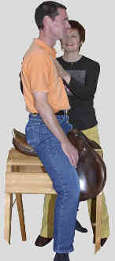Pain Relief / Improve Your Riding With The Alexander Technique

Carl Hester, Laura Bechtolsheimer and Charlotte Dujardin
The Alexander Technique is one of the most valuable tools a rider can possess.
Carl Hester, British Dressage Team, Gold Medal, London, 2012 Olympics and Dressage Team member Tokyo,2021 Olympics.
What does the Alexander Technique help?
- It helps alleviate aches and pains from horse riding
- It improves your riding by cultivating the attributes seen in top riders as follows:
- It reduces excessive tension in the rider
- It encourages the rider’s head, neck and back to work together to produce a secure seat and good position
- It helps aids appear almost invisible
- It encourages lightness and fluidity of movement
- It helps calmness and control of reaction
- It cultivates the ability to think before acting
- Qualified riding instructors often find that those having Alexander Technique lessons progress more quickly than previously.
- When the rider’s coordination improves, the horse’s performance improves as a result
What happens in an Alexander Technique session?

The originator of the Alexander Technique, F.M. Alexander, a keen rider, found that our good or poor balance/coordination in the saddle either positively or negatively affects the horse’s performance. The rider’s balance is an extension of how they move in everyday life and so this is the starting point for the Alexander Technique.

With the rider wearing normal street clothing, the teacher uses his hands to gently unravel patterns of muscular tension that hinder good riding. He then takes the rider, in a series of lessons, through everyday activities such as sitting (on the seat bones), walking, bending etc and guides her or him to carry these out in a better balanced and coordinated manner.
The skills and awareness of the body gained in this dismounted work may, where facilities are available, be transferred in later sessions to mounted work – with the rider sat on a saddle on a wooden horse – and are subsequently applied to riding in between Alexander sessions
As with any skill, the process takes time and a series of lessons is required.
What Horse Riders say
Horse rider – recovery from injuries
Having Alexander Technique has helped me recover from horse riding injuries and my riding instructor has also commented on my improved position whilst riding.
The Technique has helped me understand that holding tension in my muscles adversely affects my riding and how my horse performs. Being more ‘up’ (free from unwanted muscular tension) and relaxed has allowed me to become a better rider, have a more harmonious partnership with my horse and ultimately receive better dressage scores!
Paula
Horse rider
Regular Alexander Technique lessons have been instrumental in improving my riding style. Because I can now move in unison with my horse, this has resulted in a happier horse that is now able to carry herself with her natural elegance and grace.
I would highly recommend Derek’s Alexander Technique lessons to anyone who wishes to become a better and more sympathetic rider.
Cristina



